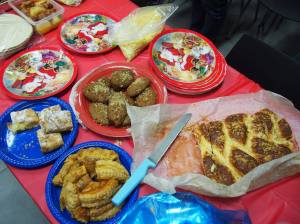An International Food Fest
As our first semester of our Master’s program comes to an end, with final papers submitted and presentations given, we decided to celebrate. And what better way to celebrate with such an ethnically diverse group of students than to feast on foods from each others homelands! Every student was asked to bring a dish that they would typically eat in their home countries to share with the class. With the multitude of different nationalities that constitute our still small MA, there was quite the bevy of tasty meals to try. Before tucking in, we asked that every student explain their dish:
Firstly, our Ukrainian student presented us with a steaming pot of borscht. A light, yet hearty soup where the primary ingredient of beetroot gave the dish a purple hue. Made in a vegetarian style, it consisted of potatoes, carrots, onions and a plethora of other veggies.

Among the Greek pastries there is borscht on the left, kimchi fried rice on the right. Photo Credit: Yoshitaka Sasaki
Our Korean student shared with us a kimchi fried rice (kimchi-bokkeumbap 김치볶음밥). This is made with the traditional spicy pickled cabbage known as kimchi along with onions and brown rice.
Brought from Japan was a vat of miso soup (味噌汁). A very traditional dish consisting of a stock called “dashi” into which softened miso paste is mixed. Green onions are the main vegetables in the soup, while tofu and seaweed are also typically added.
An Irish potato, veggie, and sausage dish was brought by our student from Malawi. Simply boiled, this meal is very common among families in Malawi.
Waakye (pronounced waachay) and a vegetable sauce were brought by our student from Ghana. A very typical dish from this country, it consists primarily of rice and beans. A great form of protein, it was delicious and nutritious! Our student also decided to mix in carrots for some added crunch.
All the way from Portugal, our MA intern shared with us Alho Francês à Brás. A leek based meal with garlic, eggs, parsley, and other spices.

Alho Francês à Brás. Photo Credit: Yoshitaka Sasaki
Representing the mixing pot that is the United States, one of our students created a chicken parmesan bread braid. This combines the typical chicken parmesan and a loaf of flakey bread, braided together and baked. Along with this dish, another US student brought soft tacos. Originally from Mexico, this is a dish that consists of ground beef spiced with cumin, chili powder, and tomato, wrapped up in a warm tortilla and topped with cheese and lettuce.
The students from Greece brought a variety of dishes that represent their nation’s gastronomy:
- Pastistio, a lasagna type dish with ground beef seasoned with cinnamon, long macaroni-like noodles, and topped with a creamy bechamel sauce.
- Dakos, typically a mezze or starter, consists of a hard barley bread that is softened by a topping of fresh tomatoes, feta, olives, and olive oil.
- Spanakopita is a traditional spinach pie, consisting of spinach and feta layered between flakey phyllo dough.
- Revithia is a chick-pea based soup with added lemon, rosemary, and oregano
- Melomakarona is a traditional Christmas soft cookie with honey, cinnamon, and orange flavors that is topped with walnuts.

Lovely display of Greek traditional art and costume on the box of spanakopita. Photo Credit: Yoshitaka Sasaki

Melomakarona on the upper right and the chicken parmesan bread braid on the left. Photo Credit: Yoshitaka Sasaki
Along with local wines and brews, this lesson in understanding each other’s cultures turned into a wonderful little party. Taking a break from academia to celebrate a semester of hard work through our common love of food.

Brittany Wade is the editor of the Initiative for Heritage Conservancy blog and student of the MA in Heritage Management 2013. Having studied Classics in her undergraduate, Brittany is interested in applying her knowledge of history in the field of archaeology. Her interests are mainly in Prehistoric Minoan and Hellenic history.

sparecake
Dec 12, 2013 at 10:09 amhttp://www.breadworld.com/Recipe.aspx?id=572 is closer to the recipe used for the chicken parm bread!